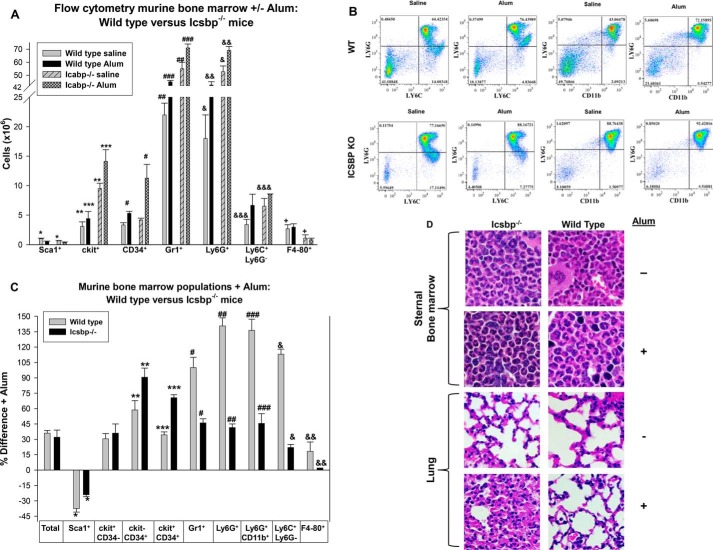FIGURE 3.
Different bone marrow populations expanded during emergency granulopoiesis in wild-type versus Icsbp−/− mice. Mice were injected with Alum to stimulate emergency granulopoiesis or saline as a steady-state control and sacrificed 2 weeks later. A, during steady-state granulopoiesis, populations of Gr1+, Ly6G+, Ly6C+Ly6G−, and c-kit+ bone marrow cells were greater in Icsbp−/− versus WT mice, and, during emergency granulopoiesis, the CD34+ population was also greater in Icsbp−/− mice. Bone marrow was evaluated by flow cytometry, and cell numbers were calculated. Statistically significant differences are indicated by *, **, ***, #, ##, ###, &, &&, &&&, and +. B, Ly6C+Ly6G+ and Ly6G+CD11b+ cells increased more in the bone marrow of WT mice in comparison with Icsbp−/− mice 2 weeks after emergency granulopoiesis stimulation. The study was repeated three times, and representative histograms are shown. C, during emergency granulopoiesis, Icsbp−/− mice had a relatively greater increase in CD34+ cell populations, but WT mice had a greater relative increase in granulocyte and monocyte populations. The data above were analyzed for percent change. Statistically significant differences are indicated by *, **, ***, #, ##, ###, &, and &&. D, sternal bone marrow from Alum-injected WT or Icsbp−/− mice showed abundant mature granulocytes, but only Alum-injected Icsbp−/− mice demonstrated pulmonary infiltration with granulocytes. Tissues were stained with H&E and examined by light microscopy at ×40 magnification. p < 0.02 was considered statistically significant.

